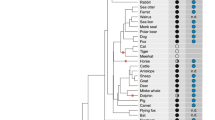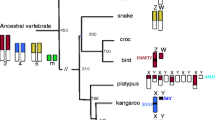Abstract
The duck-billed platypus has five pairs of sex chromosomes, but there is no information about the primary sex-determining switch in this species. As there is no apparent SRY orthologue in platypus, another gene must acquire the function of a key regulator of the gonadal male or female fate. SOX9 was ruled out from being this key regulator as it maps to an autosome in platypus. To check whether other genes in mammalian gonadogenesis could be the primary switch in monotremes, we have mapped a number of candidates in platypus. We report here the autosomal location of WT1, SF1, LHX1, LHX9, FGF9, WNT4 and RSPO1 in platypus, thus excluding these from being key regulators of sex determination in this species. We found that GATA4 maps to sex chromosomes Y1 and X2; however, it lies in the pairing region shown by chromosome painting to be homologous, so is unlikely to be either male-specific or differentially dosed in male and female.
Similar content being viewed by others
References
Albrecht KH, Eicher EM (2001) Evidence that Sry is expressed in pre-Sertoli cells and Sertoli and granulosa cells have a common precursor. Dev Biol 240: 92–107.
Baumstark A, Akhverdyan M, Schulze A, Reisert I, Vogel W, Just W (2001) Exclusion of SOX9 as the testis determining factor in Ellobius lutescens: evidence for another testis determining gene besides SRY and SOX9. Mol Genet Metab 72: 61–66.
Birk OS, Casiano DE, Wassif CA, et al. (2000) The LIM homeobox gene Lhx9 is essential for mouse gonad formation. Nature 403: 909–913.
El Mogharbel N, Wakefield M, Deakin JE, et al. (2007) DMRT gene cluster analysis in the platypus: new insights into genomic organization and regulatory regions. Genomics 89: 10–21.
Ferguson-Smith MA (2007) The evolution of sex chromosomes and sex determination in vertebrates and the key role of DMRT1. Sexual Development 1: 2–11.
Gao F, Maiti S, Alam N, et al. (2006) The Wilms tumor gene, Wt1, is required for Sox9 expression and maintenance of tubular architecture in the developing testis. Proc Natl Acad Sci USA 103: 11987–11992.
Graves JA (1995) The evolution of mammalian sex chromosomes and the origin of sex-determining genes. Philos Trans R Soc Lond B Biol Sci 350: 305–311.
Grützner F, Rens W, Tsend-Ayush E, et al. (2004) In the platypus a meiotic chain of ten sex chromosomes shares genes with the bird Z and mammal X chromosomes. Nature 432: 913–917.
Heikinheimo M, Ermolaeva M, Bielinska M, et al. (1997) Expression and hormonal regulation of transcription factors GATA-4 and GATA-6 in the mouse ovary. Endocrinology 138: 3505–3514.
Hiort O, Holterhus PM (2000) The molecular basis of male sexual differentiation. Eur J Endocrinol 142: 101–110.
Kobayashi A, Chang H, Chaboissier MC, Schedl A, Behringer RR (2005) Sox9 in testis determination. Ann NY Acad Sci 1061: 9–17.
Maccarone P, Watson JM, Francis D, Selwood L, Kola I, Graves JA (1992) The evolution of human chromosome 21: evidence from in situ hybridization in marsupials and a monotreme. Genomics 13: 1119–1124.
Manolakou P, Lavranos G, Angelopoulou R (2006) Molecular patterns of sex determination in the animal kingdom: a comparative study of the biology of reproduction. Reprod Biol Endocrinol 4: 59.
Mitchell MJ, Wilcox SA, Watson JM, et al. (1998) The origin and loss of the ubiquitin activating enzyme gene on the mammalian Y chromosome. Hum Mol Genet 7: 429–434.
Morais DS, Hacker A, Harley V, Goodfellow P, Swain A, Lovell-Badge R (1996) Sox9 expression during gonadal development implies a conserved role for the gene in testis differentiation in mammals and birds. Nat Genet 14: 62–68.
Oreal E, Mazaud S, Picard JY, Magre S, Carre-Eusebe D (2002) Different patterns of anti-Mullerian hormone expression, as related to DMRT1, SF-1, WT1, GATA-4, Wnt-4, and Lhx9 expression, in the chick differentiating gonads. Dev Dyn 225: 221–232.
Parma P, Radi O, Vidal V, et al. (2006) R-spondin1 is essential in sex determination, skin differentiation and malignancy. Nat Genet 38: 1304–1309.
Rens W, Grutzner F, O’Brien PC, et al. (2004) Resolution and evolution of the duck-billed platypus karyotype with an X1Y1X2Y2X3Y3X4Y4X5Y5 male sex chromosome constitution. Proc Natl Acad Sci USA 101: 16257–16261.
Sinclair AH, Berta P, Palmer MS, et al. (1990) A gene from the human sex-determining region encodes a protein with homology to a conserved DNA-binding motif. Nature 346: 240–244.
Smith CA, Sinclair AH (2001) Sex determination in the chicken embryo. J Exp Zool 290: 691–699.
Smith CA, Smith MJ, Sinclair AH (1999) Gene expression during gonadogenesis in the chicken embryo. Gene 234: 395–402.
Spencer JA, Watson JM, Lubahn DB, et al. (1991) The androgen receptor gene is located on a highly conserved region of the X chromosomes of marsupial and monotreme as well as eutherian mammals. J Hered 82: 134–139.
Telenius H, Pelmear AH, Tunnacliffe A, et al. (1992) Cytogenetic analysis by chromosome painting using DOP-PCR amplified flow-sorted chromosomes. Genes Chromosomes Cancer 4: 257–263.
Tevosian SG, Albrecht KH, Crispino JD, Fujiwara Y, Eicher EM, Orkin SH (2002) Gonadal differentiation, sex determination and normal Sry expression in mice require direct interaction between transcription partners GATA4 and FOG2. Development 129: 4627–4634.
Viger RS, Mertineit C, Trasler JM, Nemer M (1998) Transcription factor GATA-4 is expressed in a sexually dimorphic pattern during mouse gonadal development and is a potent activator of the Mullerian inhibiting substance promoter. Development 125: 2665–2675.
Vogel W, Jainta S, Rau W, et al. (1998) Sex determination in Ellobius lutescens: the story of an enigma. Cytogenet Cell Genet 80: 214–221.
Wallis MC, Delbridge ML, Pask AJ, et al. (2007) Mapping platypus SOX genes; autosomal location of SOX9 excludes it from sex-determining role. Cytogenet Genome Res 116: 232–234.
Watson JM, Spencer JA, Riggs AD, Graves JA (1990) The X chromosome of monotremes shares a highly conserved region with the eutherian and marsupial X chromosomes despite the absence of X chromosome inactivation. Proc Natl Acad Sci USA 87: 7125–7129.
Watson JM, Spencer JA, Riggs AD, Graves JA (1991) Sex chromosome evolution: platypus gene mapping suggests that part of the human X chromosome was originally autosomal. Proc Natl Acad Sci USA 88: 11256–11260.
Western PS, Harry JL, Marshall Graves JA, Sinclair AH (2000) Temperature-dependent sex determination in the American alligator: expression of SF1, WT1 and DAX1 during gonadogenesis. Gene 241: 223–232.
Wilcox SA, Watson JM, Spencer JA, Graves JA (1996) Comparative mapping identifies the fusion point of an ancient mammalian X-autosomal rearrangement. Genomics 35: 66–70.
Wilhelm D, Englert C (2002) The Wilms tumor suppressor WT1 regulates early gonad development by activation of Sf1. Genes Dev 16: 1839–1851.
Woodburne MO, Rich TH, Springer MS (2003) The evolution of tribospheny and the antiquity of mammalian clades. Mol Phylogenet Evol 28: 360–385.
Yamamoto I, Tsukada A, Saito N, Shimada K (2003) Profiles of mRNA expression of genes related to sex differentiation of the gonads in the chicken embryo. Poult Sci 82: 1462–1467.
Yoshioka H, Ishimaru Y, Sugiyama N, Kasahara M, Morohashi K (2004) Mesonephric Wnt signaling associate with a formation of an adreno-gonadal primordium in chick embryos. Endocr Res 30: 523.
Yoshioka H, Ishimaru Y, Sugiyama N, et al. (2005) Mesonephric FGF signaling is associated with the development of sexually indifferent gonadal primordium in chick embryos. Dev Biol 280: 150–161.
Author information
Authors and Affiliations
Corresponding author
Rights and permissions
About this article
Cite this article
Grafodatskaya, D., Rens, W., Wallis, M.C. et al. Search for the sex-determining switch in monotremes: Mapping WT1, SF1, LHX1, LHX2, FGF9, WNT4, RSPO1 and GATA4 in platypus. Chromosome Res 15, 777–785 (2007). https://doi.org/10.1007/s10577-007-1161-y
Received:
Revised:
Accepted:
Published:
Issue Date:
DOI: https://doi.org/10.1007/s10577-007-1161-y




